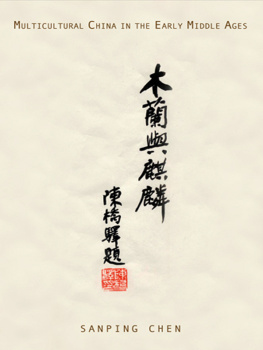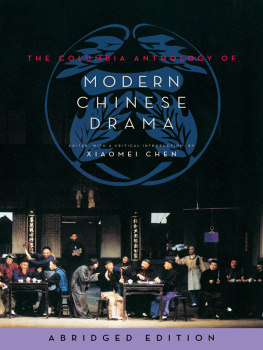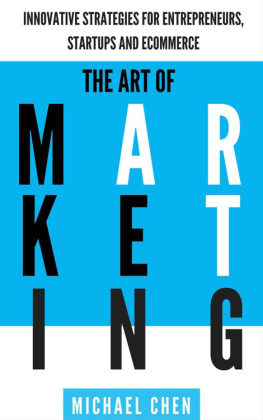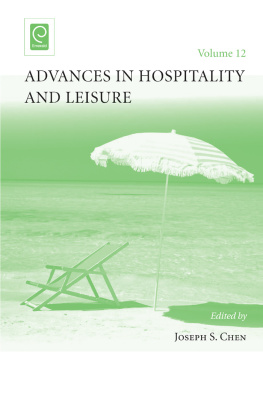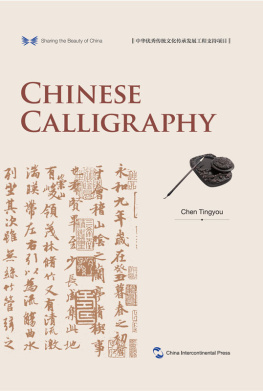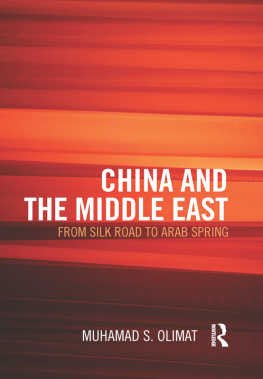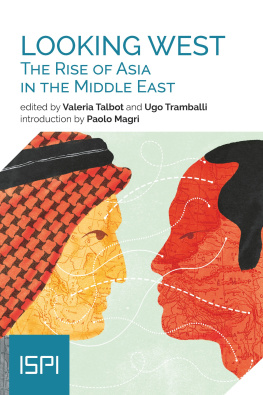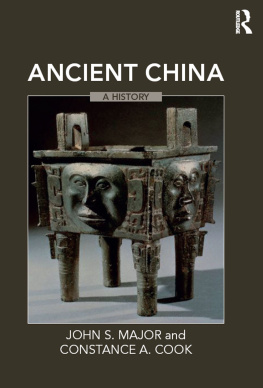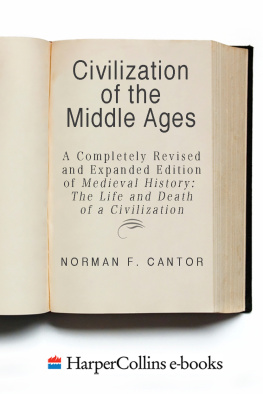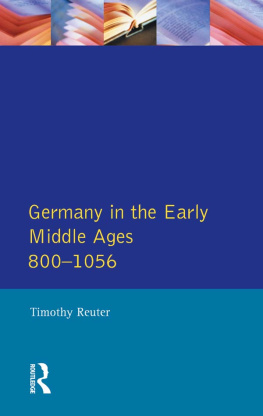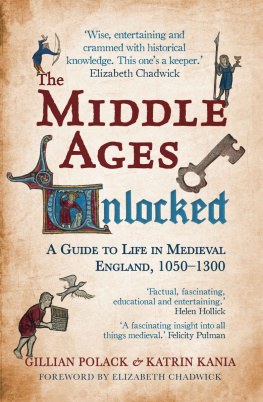Acknowledgments
After a long and rewarding journey, it is finally the time to write the acknowledgments for this book.
First of all, I thank my parents for having created an environment that facilitated my learning of Chinese classics and histories, even during a period when such learning was condemned. I thus managed to receive a self-directed education on the Confucian Canon, especially Shi jing (The Book of Songs) and Shang shu (The Book of Documents). Yet historiography remained my favorite subject. I remember vividly how the great Chinese chronicle Zizhi tongjian (Comprehensive Mirror for Aid in Government) became my beloved reading while a teenager. No less important, I was exposed early on to works by Western scholars like Paul Pelliot and thus learned that there were a lot more than just Sinitic sources on Asian history. Moreover, the Chinese calligraphy on the cover referring to the title of was penned by my father.
Growing up during the height of the Cultural Revolution in China embedded me with a life-long distrust of official records and similarly one-sided sources, however less biased they might have been than their latter-day counterparts. Many segments of this book have been, at least partially, prompted by such suspicions and doubts.
Of all the scholars I have had the opportunity to be associated with, I would foremost like to thank the late Denis Sinor. He not only published my first study in English with kind encouragement, but also, befitting his own meticulous training under Matre Pelliot, demonstrated the rigor standards that one's research should be held up to. I have also handsomely benefited from his yet-to-be-surpassed Introduction l'tude de l'Eurasie centrale.
I owe another great Denis, the late Denis Twitchett, whose personal letters were much more than just encouragement. A segment of of this book was developed from his ideas. I also learned from these exchanges the intellectual openness and breadth of a true master in Sinology.
In addition to Giovanni Stary, who has always been supportive of my research by accepting my submissions within days or even hours, thanks are also due to the Royal Asiatic Society of Great Britain and Ireland, which bestowed upon me the 1996 Major Barwis-Holliday Award. Such an honor to a relative outsider greatly helped me continue my research in an environment not conducive to Asian studies.
The fact of the matter is that, during the entire research period for the materials covered in this book, I have always lived in a city that does not have an Asian library, much less the modern Western publications and journals indispensable to my research. Other than my own meagre bookshelves, for many years, almost all substantive references were procured via slow and cumbersome interlibrary loans from across North America. While the Internet has in recent years mitigated this situation significantly, I am still hampered by a lack of access to a research library in humanities, let alone one in Asian studies. Hence my advance apologies to readers of this book for any missed references.
I thank my wife for her understanding and support, and my son for helping secure many hard-to-find references during his four undergraduate years at Harvard.
Over the years, many people have provided help in securing important references. I would like to mention in particular Samuel Adshead for the late Joseph Fletcher's conference paper on blood tanistry, and Jonathan Silk for his book manuscript Riven by Lust.
I thank my good friend Chung-mo Kwok for years of stimulating outside- the-box discussions about medieval China, including the one leading to our joint paper on the proto-Mongolian origin of the popular Chinese slur word nucai. I also thank Paul Kroll for his detailed suggestions and comments on earlier drafts of the study that later becomes of this book.
I acknowledge my debt and gratitude to several earlier masters, in particular Paul Pelliot, Berthold Laufer, and Peter Boodberg, who pioneered the modern study of ancient xeno-Sinitic exchanges. More admiringly, they set the example of conducting fruitful research on subjects whose source materials are patchy and sporadic, in sharp contrast to other areas in which the output is proportional to the quantity of available sources.
I am deeply indebted to reviewers of my manuscript, who helped to improve the book by correcting my many errors, inaccuracies, and insufficiently substantiated claims. I must in particular thank Peter Golden, whose repeated readings contributed so much to the book, not the least by adding numerous important and up-to-date references.
Thanks are also due to the editors and staff of the University of Pennsylvania Press, especially Peter Agree, Julia Rose Roberts, and Erica Ginsburg. Their meticulous and constructive work greatly enhanced the quality of the book.
Last but not least, my thanks go to the editor of this series, Victor Mair, who not only suggested this title several years ago but also patiently and painstakingly nurtured every step in its preparation: the current book would not be in readers' hands but for his persistent support, encouragement, and contributions.
Appendix
Turkic or Proto-Mongolian?
A Note on the Tuoba Language
As discussed in various chapters of this book, the Tuoba, or Tabach, as they are recorded in the Orkhon inscriptions, played a critical role in the history of China, not only for founding the Northern (or Late) Wei dynasty (386-534), but also and perhaps more importantly for having created two heirs, both political and biological, the Sui (581618) and the Tang (618907). The linguistic affinity of this important group, however, has remained to this day an enigma. As Denis Sinor summarizes the situation in his Introduction l'tude de l Eurasie centrale, most scholars agree that the Tuoba language belonged to the Altaic family. But controversy and contention arise with the simple question: Were the Tuoba Turkic or proto-Mongolian?
There are prominent names among the proponents of either of the two rival claims. For proponents of the Turkic theory, one can cite Paul Pelliot, Peter Bood-berg, and Sir Gerard Clauson,
The primary reason for this controversy is the scarcity of relevant linguistic data. The secondary reasons are twofold. First, there is evidence for both Turkic and proto-Mongolian elements in the Tuoba federation, as can be expected of most Steppe empires. The other factor is that the Tuoba is usually regarded as having formed part of the Xianbei complex or conglomerate, which was generally considered, with good evidence, to be largely proto-Mongolian.
Given time and luck, some future archeological breakthrough, or another chance find like the Dunhuang hoard stumbled upon in the early twentieth century, may finally solve this mystery. But before this takes place, if it ever does, one may still uncover new linguistic evidence pertinent to this issue by adopting a novel and perhaps unconventional perspective from which to examine the known historical data. This study is a tentative step in this direction.
The Tuoba's Sinification Drive
In the last decade of the fifth century, the Tuoba emperor Xiaowen (Yuan Hong; reign 47199) launched his famous sinification drive, moved his court from Pingcheng in the north to the old Chinese capital of Luoyang, and formally proscribed the Xianbei language, customs, clothing, and names. This move was no doubt driven by the young emperor's ambition to put a final end to the north-south division of China. What this appendix discusses is the conversion of almost all Barbarian family (i.e., tribe) names, including the very royal clan name Tuoba, to Chinese or Chinese-sounding surnames.
One should first mention the strong nationalistic resistance to this wholesale abandonment of the Tuoba's cultural heritage, something that Emperor Xiaowen was fully aware of and indeed anticipated. As discussed earlier in this book, the opposition proved so strong that even Emperor Xiaowen's eldest son and heir-designate, Yuan Xun, became entangled in the resistance movement that eventually cost the young crown prince his life. It was also amply attested in a Xianbei revival movement after the collapse of the Northern Wei, in the wake of the Six-Garrison Rebellion started by frontier garrisons disillusioned with the sinified Tuoba court in Luoyang. All these reactions indicate that Emperor Xiaowen must have proceeded discreetly and skillfully to alleviate the resentment and opposition of his tribal comrades apparently still very much attached to their Steppe heritage. His careful and tactful approach is evidenced by the provisions and exceptions the emperor had granted to the older folks, as well as the so-called wild-goose courtiers
Next page
